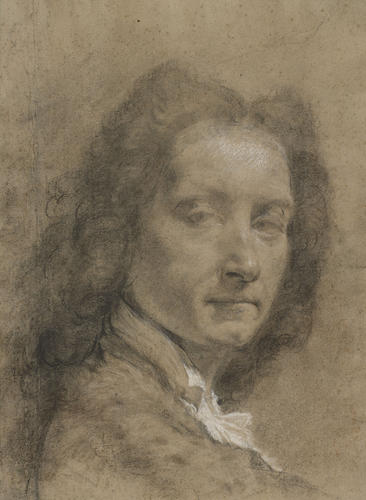A self-portrait c. 1730
Black and white chalks on discoloured blue (now brown) paper | 39.4 x 29.6 cm (sheet of paper) | RCIN 990754
-
A self-portrait drawing of Giovanni Battista Piazzetta. His shoulders are turned to the right, and his head is turned three-quarters to the right. He wears a dark curling wig.
Piazzetta often used his wife, his son and himself as models for his drawings and paintings. Although few of his drawn heads are explicit portraits, this drawing is a straightforward self-portrait and was engraved as such by Giovanni Cattini in 1743. In Vienna (Albertina) is a dated self-portrait drawing of 1735 in which Piazzetta appears a few years older, suggesting a date around 1730 for the present drawing.
That dating does, however, assume that Piazzetta was here recording his features as they then appeared, for he also executed ‘idealised’ self-portraits that show him younger than in reality. A small etching of 1738, when he was 56 years old, depicts him as no more than a youth (with the velvet beret and plume in conscious emulation of Rembrandt’s self-portrait etchings of a century earlier); and it is almost certain that in RCIN 990780 he is depicting himself as a younger man. The fantasy extends to his presentation – the formal wig of RCIN 990754 has given way to an unruly mop of natural hair, a tasselled velvet cloak is thrown over one shoulder of his loose shirt and he rests his hand on a rough staff: the urbane artist is imagining himself as a rustic and somewhat romanticised peasant, who recurs in Piazzetta’s painting of a Fête Champetre in the Wallraf-Richartz-Museum, Cologne.
Giovanni Battista Piazzetta’s paintings, sombre in tone and large in form, are among the most impressive examples of late Baroque art in Venice. But his most distinctive works were his drawings of ‘character types’ (in the tradition of the tronies of Rembrandt and Castiglione – see RCIN 404120, RCIN 830472.g), usually one or two bust-length figures, executed in black and white chalks on blue paper that has in every case faded to a dull brown, for they were finished works to be framed and hung. These drawings ostensibly depict priests, philosophers, bravos, 'Gypsies', 'Moors', 'Turks' and other 'exotic' types, frequently borrowed in pose and facial features from the figures in his paintings but re- (or de-)contextualised. The Royal Collection holds 36 such drawings, the largest group in existence.
Text adapted from Portrait of the Artist, London, 2016Provenance
Probably among those mentioned in Pietro Guarienti's additions to Orlandi's Abecedario (Venice, 1753), p. 280, 'le teste egregiamente fatte a chiaroscuro sono nella galleria doviziosissima del Signor Giuseppe Smith Console Inglese' and acquired by George III from Consul Joseph Smith in 1762
-
Medium and techniques
Black and white chalks on discoloured blue (now brown) paper
Measurements
39.4 x 29.6 cm (sheet of paper)
Object type(s)









